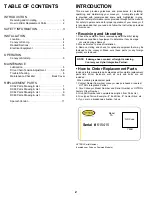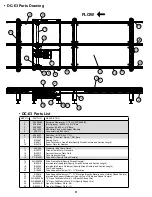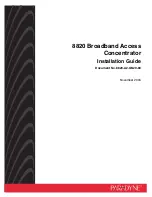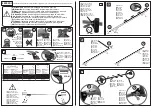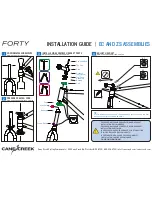
3
SAFETY INFORMATION
• Installation
GUARDS AND GUARDING
Interfacing of Equipment. When two or more pieces of equipment are
interfaced, special attention shall be given to the interfaced area to
insure the presence of adequate guarding and safety devices.
Guarding Exceptions
. Whenever conditions prevail that would
require guarding under these standards, but such guarding would
render the conveyor unusable, prominent warning means shall be
provided in the area or on the equipment in lieu of guarding.
Guarded by Location or Position.
Where necessary for the
protection of employees from hazards, all exposed moving machinery
parts that present a hazard to employees at their work station shall
be mechanically or electrically guarded, or guarded by location or
position.
•
Remoteness from frequent presence of public or employed
personnel shall constitute guarding by location.
•
When a conveyor passes over a walkway, roadway, or work
station, it is considered guarded solely by location or position if all
moving parts are at least 8 ft. (2.44 m) above the floor or walking
surface or are otherwise located so that the employee cannot
inadvertently come in contact with hazardous moving parts.
•
Although overhead conveyors may be guarded by location, spill
guards, pan guards, or equivalent shall be provided if the product
may fall off the conveyor for any reason and if personnel would
be endangered.
HEADROOM
•
When conveyors are installed above exit passageways, aisles,
or corridors, there shall be provided a minimum clearance of 6
ft. 8 in. (2.032 m) measured vertically from the floor or walking
surface to the lowest part of the conveyor or guards.
•
Where system function will be impaired by providing the minimum
clearance of 6 ft. 8 in. (2.032 m) through an emergency clearance,
alternate passageways shall be provided.
•
It is permissible to allow passage under conveyors with less
than 6 ft. 8 in. (2.032 m) clearance from the floor for other than
emergency exits if a suitable warning indicates low headroom.
• Operation
A) Only trained employees shall be permitted to operate conveyors.
Training shall include instruction in operation under normal conditions
and emergency situations.
B) Where employee safety is dependent upon stopping and/or
starting devices, they shall be kept free of obstructions to permit
ready access.
C) The area around loading and unloading points shall be kept clear
of obstructions which could endanger personnel.
D) No person shall ride the load-carrying element of a conveyor
under any circumstances unless that person is specifically authorized
by the owner or employer to do so. Under those circumstances, such
employee shall only ride a conveyor which incorporates within its
supporting structure platforms or control stations specifically designed
for carrying personnel. Under no circumstances shall any person ride
on any element of a vertical conveyor.
E) Personnel working on or near a conveyor shall be instructed as to
the location and operation of pertinent stopping devices.
F) A conveyor shall be used to transport only material it is capable
of handling safely.
G) Under no circumstances shall the safety characteristics of the
conveyor be altered if such alterations would endanger personnel.
H) Routine inspections and preventive and corrective maintenance
programs shall be conducted to insure that all safety features and
devices are retained and function properly.
I) Personnel should be alerted to the potential hazard of entanglement
in conveyors caused by items such as long hair, loose clothing, and
jewelry.
J) Conveyors shall not be maintained or serviced while in operation
unless proper maintenance or service requires the conveyor to be in
motion. In this case, personnel shall be made aware of the hazards
and how the task may be safely accomplished.
K) Owners of conveyor should insure proper safety labels are affixed
to the conveyor warning of particular hazards involved in operation of
their conveyors.
• Maintenance
•
All maintenance, including lubrication and adjustments, shall be
performed only by qualified and trained personnel.
•
It is important that a maintenance program be established to
insure that all conveyor components are maintained in a condition
which does not constitute a hazard to personnel.
•
When a conveyor is stopped for maintenance purposes, starting
devices or powered accessories shall be locked or tagged out
in accordance with a formalized procedure designed to protect
all persons or groups involved with the conveyor against an
unexpected start.
•
Replace all safety devices and guards before starting equipment
for normal operation.
•
Whenever practical, DO NOT lubricate conveyors while they are
in motion. Only trained personnel who are aware of the hazard
of the conveyor in motion shall be allowed to lubricate.
Safety Guards
Maintain all guards and safety devices IN POSITION and IN SAFE
REPAIR.
Safety Labels
In an effort to reduce the possibility of injury to personnel working
around HYTROL conveying equipment, safety labels are placed at
various points on the equipment to alert them of potential hazards.
Please check equipment and note all safety labels. Make certain
your personnel are alerted to and obey these warnings. See Safety
Manual for examples of warning labels.
CAUTION!
Because of the many moving parts on the conveyor, all personnel
in the area of the conveyor need to be warned that the conveyor is about to
be started.
REMEMBER
Do not remove, reuse or modify material handling equipment
for any purpose other than it’s original intended use.
Summary of Contents for DC62
Page 15: ...15 ...


